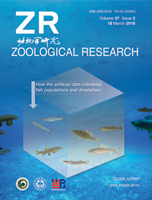
|
Zoological Research
Kunming Institute of Zoology, Chinese Academy of Sciences
ISSN: 2095-8137
Vol. 32, No. 3, 2011, pp. 255-261
|
 Bioline Code: zr11036
Bioline Code: zr11036
Full paper language: Chinese
Document type: Research Article
Document available free of charge
|
|
|
Zoological Research, Vol. 32, No. 3, 2011, pp. 255-261
| en |
Genetic differentiations between randomly and selectively bred pig populations in Yunnan, China
Qu, Kai-Xing; Wu, Gui-Sheng; Gao, Xiao; Yan, Da-Wei; Lian, Lin-Sheng; Baig, Mumtaz & Zhang, Ya-Ping
Abstract
To assess the genetic diversity between randomly and selectivelybred populations, we sequenced 438 bp of the mitochondrial DNA control region from 102 pigs. These samples represented four native pig breeds, one nucleus and one conservation herd from Yunnan, China. Twenty haplotypes with sixteen polymorphic sites were identified. The number of haplotypes in the nucleus herd of Saba pig and the conservation herd of Banna miniature pig were restricted to three and one, respectively, while the randomly bred pig populations exhibited over six haplotypes. Notably, haplotype diversity in randomly bred populations was significantly greater than the selectively bred populations (h=0.732 vs. 0.425 and 0, exact test, P≤ 0.0036). These findings demonstrate that selective breeding generated low genetic diversity compared to randomly bred pig breeds. A timely intervention and well programmed breeding approach would stop further genetic diversity reduction in the nucleus and conservation herds of native pig breeds. Otherwise, selective breeding would dramatically reduce genetic diversity in only several years, indicating that sharp contradictions exist between breeding, conservation and genetic diversity. Genetic relationships are discussed based on net genetic distances among pig populations.
Keywords
Yunnan; pig breeds; Genetic diversity; Randomly bred population; Selectively bred population
|
| |
© Copyright 2011 Kunming Institute of Zoology, the Chinese Academy of Sciences
Alternative site location: http://www.zoores.ac.cn/
|
|
